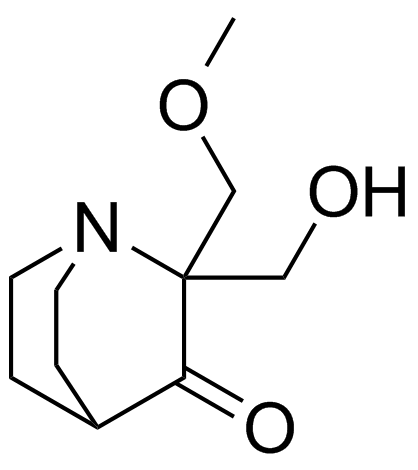5291-32-7
| Name | 2-(hydroxymethyl)-2-(methoxymethyl)-1-azabicyclo[2.2.2]octan-3-one |
|---|---|
| Synonyms |
1-Azabicyclo[2.2.2]octan-3-one, 2-(hydroxymethyl)-2-(methoxymethyl)-
2-(Hydroxymethyl)-2-(methoxymethyl)quinuclidin-3-one UNII-Z41TGB4080 3-Quinuclidinone,2-(hydroxymethyl)-2-(methoxymethyl) 2-Methoxymethyl-2-methylol-3-chinuclidinon APR-246 2-hydroxymethyl-2-methoxymethyl-1-aza-bicyclo[2.2.2]octan-3-one UNII:Z41TGB4080 Prima 1MET PRIMA-1Met |
| Description | PRIMA-1MET restores wild-type conformation and function to mutant p53, and triggers apoptosis in tumor cells. PRIMA-1MET also targets the selenoprotein thioredoxin reductase 1 (TrxR1), a key regulator of cellular redox balance. |
|---|---|
| Related Catalog | |
| Target |
p53 activator[1] TrxR1 inhibitor[1] |
| In Vitro | APR-246 inhibits both recombinant TrxR1 in vitro and TrxR1 in cells. Cellular TrxR1 activity is inhibited by APR-246 irrespective of p53 status. APR-246 can directly affect cellular redox status via targeting of TrxR1. Several small molecules have been shown to restore wild-type activity to mutant p53, including CP-31398, PRIMA-1 and APR-246 (PRIMA-1MET), MIRA, STIMA, PhiKan-083 and NSC319726. PRIMA-1 and its methylated analog APR-246 promote correct folding of mutant p53, induce cell death by apoptosis, and inhibit tumor growth in mice. APR-246 has also been shown to reactivate mutant forms of the p63 and p73 proteins that share high structural homology with p53[1]. PRIMA-1MET is a powerful apoptosis-inducing agent. PRIMA-1MET can enhance apoptosis in mutant p53 carrying cells, compared to the p53 null parental cells. Most p53 mutants are in complex with Hsp70 proteins. PRIMA-1MET treatment increases Hsp70 expression and nucleolar translocation, in parallel with the induction of nucleolar accumulation of mutant p53. Several lines of evidence suggest that PRIMA-1MET can also act independently of the p53 status of the cell. It can radiosensitize prostate carcinoma cell lines with mutant or wild type p53 and p53-/- cells as well. Introduction of mutant p53 (p53ser249 or p53gln248) into p53-/- hepatocarcinoma cells increases sensitivity to PRIMA-1MET without the induction of p53 target genes. PRIMA-1MET regularly induces apoptosis in mutant p53 expressing cells[2]. |
| Kinase Assay | Cells are plated in six-well plates at a density of 15 000 cells per cm2. Next day, cells are treated with different concentrations of APR-246 (0, 25, 50, 75 and 100 μM) and harvested after 4, 12 and 24 h. The cells are lysed, and the clarified supernatants are used for either analysis of TrxR enzymatic activities or western blot. Total protein concentrations are determined with a Bradford reagent kit. Cellular TrxR activity is measured using an adapted Trx-dependent end point insulin reduction assay for microwell plates[1]. |
| References |
| Density | 1.2±0.1 g/cm3 |
|---|---|
| Boiling Point | 313.8±17.0 °C at 760 mmHg |
| Molecular Formula | C10H17NO3 |
| Molecular Weight | 199.247 |
| Flash Point | 143.6±20.9 °C |
| Exact Mass | 199.120850 |
| PSA | 49.77000 |
| LogP | 0.61 |
| Vapour Pressure | 0.0±1.5 mmHg at 25°C |
| Index of Refraction | 1.537 |
| Storage condition | -20℃ |
| HS Code | 2933990090 |
|---|
| HS Code | 2933990090 |
|---|---|
| Summary | 2933990090. heterocyclic compounds with nitrogen hetero-atom(s) only. VAT:17.0%. Tax rebate rate:13.0%. . MFN tariff:6.5%. General tariff:20.0% |
